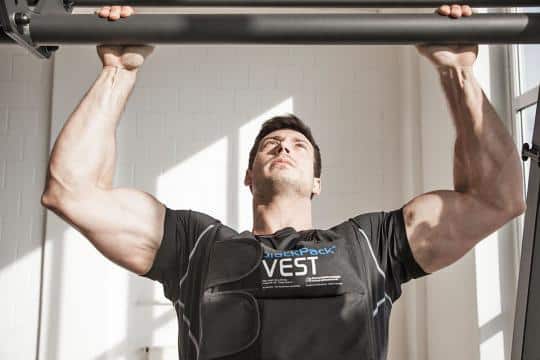Pull-ups: Everyone knows them, but few dare to do them. With regular practice and a good dose of willpower, you too can train your entire upper body with this highly effective fitness exercise—and have a lot of fun in the process!
This is why pull-up training should be on your schedule
Why should you be pulling yourself up on a bar? Because pull-ups strengthen your back, chest, abdominal, and upper arm muscles. You’ll also burn fat and improve coordination long after the workout ends. Best of all, you don’t need elaborate equipment. Besides a chin-up bar, you can use a sturdy branch, scaffolding, or door frame—just make sure it can actually support your weight.
What to watch out for during pull-up workouts
Simply hanging from a bar won’t get you far. With pull-ups, proper execution is crucial to effectively engage your muscles. Be patient and perform the exercise in a controlled manner. Only train on the pull-up bar when you’re fit to execute the movement correctly. You can choose from several variations of pull-ups to target different muscle groups.
- Shoulder-width grip: The standard starting variant. Grab the pull-up bar with palms facing forward, cross your feet, and lift without swinging. Pull your shoulder blades together and raise yourself until your chin rises above the bar.
- Wide overhand grip: Focuses primarily on back muscles while sparing the shoulders.
- Tight underhand grip: Reduces back engagement and targets the biceps.
Get a proper grip
Start with the right grip. Place your fingers side by side and wrap your thumbs around the bar for a secure hold. Hang in a relaxed position with your arms almost fully extended.
Arms, legs, and shoulder blades
Pull your shoulder blades together, activate your core muscles, and cross your legs slightly to avoid uncontrolled swaying. This will help maintain stability during the exercise.
Pull up and lower properly
Slowly bring your chest up to bar height without momentum, keeping constant torso tension. Look forward and raise your chin above the bar. Lower yourself back down in a controlled manner until your arms are almost fully extended. Repeat for multiple reps if you can.
Common mistakes in pull-up training
To avoid injury and ensure effective training, avoid these common mistakes:
- Using momentum: Don’t swing your legs. Pull yourself up using muscle strength alone.
- Half measures: Perform the full range of motion—don’t stop short or drop suddenly.
- Incorrect breathing: Never hold your breath. Inhale as you pull up and exhale as you lower yourself.
Tips for beginners and advanced users
Pull-up training is possible for everyone, from beginners to seasoned athletes. Stay patient, keep challenging yourself, and mix things up for consistent progress.
For beginners:
- Start by strengthening your arms and latissimus dorsi. A rope trainer or sling trainer is great for this.
- Ask for support: Have someone hold your legs to reduce the weight you need to lift.
- Stand on a step or chair to shorten the distance to the bar.
- Use a powerband for assistance. Kneel on the band to reduce resistance.
- Shorten the movement: Start at the top and slowly lower yourself down.
For advanced users:
- Vary your pace: Go up quickly and down slowly, or the reverse.
- Change your grip: Use wide, narrow, overhand, underhand, or hammer grips.
- Incorporate weights with an adjustable weight vest to push past your bodyweight limits.
Conclusion: The more flawless the technique, the greater the success
Whether with support or bare hands, pull-up training is ideal for building muscle at any fitness level. These demanding exercises require discipline, the right technique, and regular practice. Master these elements, and pull-up training will bring you long-term success and enjoyment!



Leave a comment
All comments are moderated before being published.
This site is protected by hCaptcha and the hCaptcha Privacy Policy and Terms of Service apply.